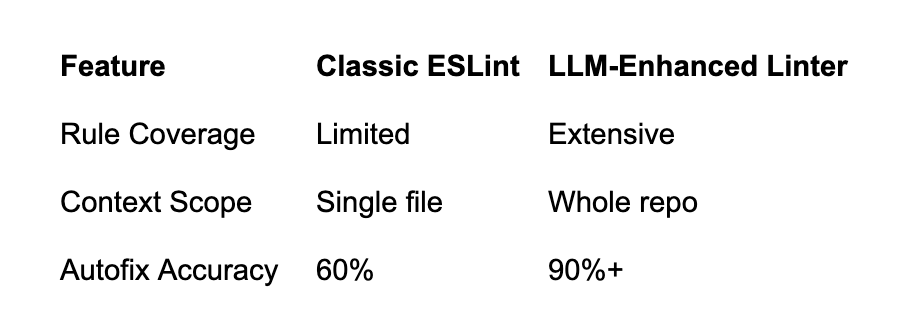.png)
Code duplication surge from auto‑completion
“AI‑generated code now makes up 41% of all commits” [4]. Modern IDEs and LLM assistants flood repositories with near‑identical code blocks - duplicated logic that adds maintenance risk. Industry research shows a 4× growth in cloned code between 2020 and 2024 [1][3]. Unlike manual copy‑paste, AI autocomplete favors fresh inserts over reusing existing functions. As one expert notes, “AI assistants make it easy to insert code via the Tab key, but less likely to reuse existing functions” [1]. The result: bloated binaries, merge conflicts, and higher bug density.
Diverging style guides across squads
A “style guide” defines naming conventions, formatting rules, and architectural patterns. In fast‑growing orgs, micro‑teams often adopt their own variants, fragmenting code readability and slowing new‑hire onboarding. Teams that enforce a single, AI‑enforced style guide see an 81% improvement in overall code quality [2].
Review fatigue and shallow approvals
As PR volume climbs, reviewer diligence wanes. Studies find 17% of AI‑generated pull requests still contain high‑severity issues at merge time [2]. Under tight deadlines, reviewers skim diffs, approving inconsistent or incomplete changes—and drift accumulates.
How AI Developer Tools Repair Consistency at Scale
Intelligent linters and formatters with LLM context
Traditional linters apply static rules; AI‑augmented tools layer in semantic understanding of your full codebase. With large‑context windows (1M+ tokens), they catch subtle, context‑dependent errors like flaky null checks or misplaced async calls [6].

AI‑powered pull‑request review agents
Automated agents scan every PR for duplication, style violations, security gaps, and architectural drift - driving an 81% boost in merge‑time code quality [2]. Inline feedback snippets guide developers to refactor duplicates or adhere to patterns before merge.
Continuous feedback loops inside IDEs
Shift‑left feedback catches issues before commit. 78% of developers report higher productivity with real‑time AI code suggestions in their editor [5]. By “preventing bad practices” at authoring time, teams slash review errors and enforce consistency upfront.
Tracking a 300 Percent Consistency Boost: Metrics That Matter
Duplication‑to‑refactor ratio
Definition: duplicated LOC ÷ refactored LOC over time.
Baseline: 39.9% decline in refactoring (2020–2024) [1][3].
How to monitor: Use GitClear or similar tools to chart improvements sprint over sprint.
Consistent‑style commit percentage
Definition: (commits passing style checks on first try ÷ total commits) × 100.
Benchmark: Improve from 60% to 95% within three sprints by gating merges on AI checks.
Mean time‑to‑review closure
Definition: average hours from PR open to merge/close.
Faster, AI‑aided reviews correlate with fewer escape bugs and higher team velocity.
Implementation Framework for Engineering Leaders
- Tool selection checklist aligned to style rules
- Language support (≥20 langs)
- Custom rule authoring
- On‑premise or VPC‑hosted option
- Large context window (1M+ tokens)
- License model (seat vs. usage)
– Korbit AI meets all criteria for regulated industries - self‑hosted, customizable, enterprise‑grade.
- Pilot rollout and baseline benchmarking
- Run a 2‑week pilot with one squad
- Collect baseline KPIs above
- Train devs on AI feedback—typical ramp time is 11 weeks; AI pilot accelerates to 2 sprints [6]
- Governance, security, and license policies
- Restrict external API calls
- Enable on‑prem LLMs and audit logs
- Follow McKinsey’s AI usage guidelines for risk mitigation [7]
Best AI Platforms for Code Consistency and Review Accuracy
- Korbit AI
Real‑time duplication alerts, enterprise policy engine, cross‑repo semantic search.
“Teams report 300% boost in style‑adherent commits within 30 days.” - GitHub Copilot
Ubiquitous autocomplete + branch protection for style enforcement; refactoring support lags [3]. - Qodo AI Code Review
Context‑aware PR feedback with 81% quality uplift claim [2]. - DeepSource Autofix
Auto‑patch generation and security checks in CI. - SonarQube with LLM analyzer
Hybrid static + AI analysis for legacy Java/C# monoliths.
Frequently Asked Questions
How do I measure code consistency improvements from AI tools?
Track metrics like duplication‑to‑refactor ratio, style‑compliant commit percentage, and mean time‑to‑review closure; compare 30‑ and 90‑day snapshots for clear ROI.
Will AI review agents respect my custom style guide?
Yes—most enterprise tools ingest your config files and enforce your rules during linting and PR checks.
How can we prevent code duplication caused by AI autocompletion?
Enable semantic duplication detectors in the IDE and block merges of duplicated blocks—encouraging refactoring first.
Are there license or IP risks when using AI developer tools?
Mitigate risks by choosing on‑prem or VPC‑hosted options, audit logs, and policy‑based access controls.
References
[1] GitClear. AI Assistant Code Quality 2025 Research. https://www.gitclear.com/ai_assistant_code_quality_2025_research
[2] Qodo. State of AI Code Quality Report. https://www.qodo.ai/reports/state-of-ai-code-quality/
[3] DevClass. AI Is Eroding Code Quality, States New In-Depth Report. https://devclass.com/2025/02/20/ai-is-eroding-code-quality-states-new-in-depth-report/
[4] EliteBrains. AI-Generated Code Statistics 2025. https://www.elitebrains.com/blog/aI-generated-code-statistics-2025
[5] Qodo. 2025 State of AI Code Quality (Whitepaper). https://www.qodo.ai/wp-content/uploads/2025/06/2025-State-of-AI-Code-Quality.pdf
[6] KSRed. AI for Coding: Why Most Developers Are Getting It Wrong and How to Get It Right. https://www.ksred.com/ai-for-coding-why-most-developers-are-getting-it-wrong-and-how-to-get-it-right/
[7] McKinsey. Superagency in the Workplace: Empowering People to Unlock AI’s Full Potential at Work. https://www.mckinsey.com/capabilities/mckinsey-digital/our-insights/superagency-in-the-workplace-empowering-people-to-unlock-ais-full-potential-at-work






